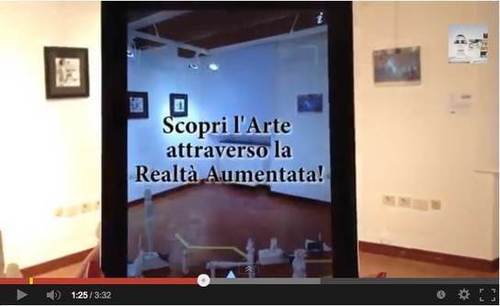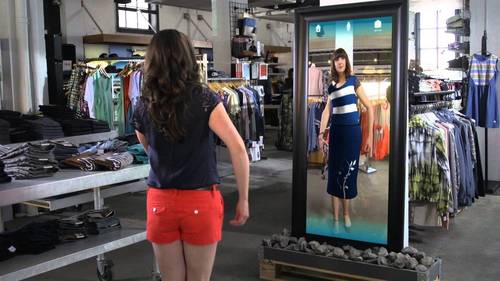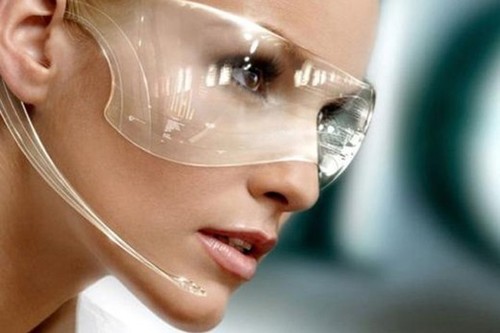Ott 17, 2013 | News on Augmented, Mixed and Virtual Reality
See on Scoop.it – augmented world

Musical itineraries to celebrate the 200th anniversary of Giuseppe Verdi’s birth
“Muri e divisioni” (“Walls and divisions”) is the title of the Macerata Opera Festival 2013. An edition completely devoted to the opera composer Giuseppe Verdi to celebrate the 200th anniversary of his birth. A call for artists was organized by Adam Accademia delle Arti, a local no-profit organization composed by 40 artists, to collect proper artworks for the exhibition. An augmented reality (AR) experience was planned to engage visitors with Verdi’s music, from Nabucco and Il Trovatore. The event exhibition “Muri e divisioni” took place from July 18th to September 29th 2013 in a Gallery called Palazzo Galeotti located in the city centre. To live the augmented reality performance, 7 auras were made. Two musical paths were created: one was based on “Dio di Giuda”, “S’appressan gl’istanti” and “Va pensiero” from Nabucco; another “Di quella pira”, “Tacea la notte placida”, “Terzetto Anima mia!” and “Stride la vampa” from Il Trovatore. The music augmented 7 artworks of the painters: Simona Breccia, Hernàn Chavar, Dorian X, Gabriella Gattari, Luna Simoncini, Marco Temperini and Tomas.
augmented world‘s insight:
The augmented reality has been created to make visitors perform a unique experience in a contemporary art gallery. The public may dynamically live something special, while appreciating paintings and installations. Giuseppe Verdi’s music augments pieces of art and specific gestures appear at the same time. The visitor has to abandon his/her apathy to perform something unexpected and to enjoy the two itineraries.
The augmented reality experience was designed and realized by Mirco Compagno (AR techno-scientific researcher) and Giuliana Guazzaroni (AR researcher) for Adam Accademia delle Arti.
The AR Performance
The artists weren’t been advised about the augmented reality that modifies their works. Some painters were enthusiastic, other showed attention in the experience and one wasn’t completely satisfied by the selected music for his canvas. The public reacted in different ways. In general, they were amazed and engaged by the first performer, a person that modelled the AR experience for visitors, and participated to the experience. Moreover, an ex-post questionnaire was distributed to 50 users in order to collect useful information for the evaluation. Most of the participants declared to have truly enjoyed the AR performance (60%); 20% said to have enjoyed it and 20% declared to have hardly enjoyed it. For 48% of the public the activity performed highly promoted an emotional bond with contemporary art. For 36% of the visitors the activity performed promoted an emotional bond and for 16% scarcely promoted it.
Most of the visitors declared that they would really recommend AR experiences to other people (68%); 16% would warn such experiences and 16% would hardly recommend them. As for technological difficulties, most of the public could easily enjoy the performance (80%), while 20% declared to have encountered problems using the AR browser in their smartphones or tablets (e.g. obsolete operating system etc.). An interviewed visitor said: “it was engaging and exciting to participate in the exhibition “Walls and divisions” that allows people to deal with art in a different and touching way. Thanks to AR there is no longer a simple contemplation, but a real opportunity to experience the exhibition as a whole. Moreover, it becomes a real chance to share feelings with other spectators. A new way to enjoy contemporary art merged in a new surreal dimension”.
See on www.theround.it
Ott 17, 2013 | News on Augmented, Mixed and Virtual Reality
Musical itineraries to celebrate the 200th anniversary of Giuseppe Verdi’s birth
“Muri e divisioni” (“Walls and divisions”) is the title of the Macerata Opera Festival 2013. An edition completely devoted to the opera composer Giuseppe Verdi to celebrate the 200th anniversary of his birth. A call for artists was organized by Adam Accademia delle Arti, a local no-profit organization composed by 40 artists, to collect proper artworks for the exhibition. An augmented reality (AR) experience was planned to engage visitors with Verdi’s music, from Nabucco and Il Trovatore. The event exhibition “Muri e divisioni” took place from July 18th to September 29th 2013 in a Gallery called Palazzo Galeotti located in the city centre. To live the augmented reality performance, 7 auras were made. Two musical paths were created: one was based on “Dio di Giuda”, “S’appressan gl’istanti” and “Va pensiero” from Nabucco; another “Di quella pira”, “Tacea la notte placida”, “Terzetto Anima mia!” and “Stride la vampa” from Il Trovatore. The music augmented 7 artworks of the painters: Simona Breccia, Hernàn Chavar, Dorian X, Gabriella Gattari, Luna Simoncini, Marco Temperini and Tomas.

The augmented reality has been created to make visitors perform a unique experience in a contemporary art gallery. The public may dynamically live something special, while appreciating paintings and installations. Giuseppe Verdi’s music augments pieces of art and specific gestures appear at the same time. The visitor has to abandon his/her apathy to perform something unexpected and to enjoy the two itineraries.
The augmented reality experience was designed and realized by Mirco Compagno (AR techno-scientific researcher) and Giuliana Guazzaroni (AR researcher) for Adam Accademia delle Arti.
The AR Performance
The artists weren’t been advised about the augmented reality that modifies their works. Some painters were enthusiastic, other showed attention in the experience and one wasn’t completely satisfied by the selected music for his canvas. The public reacted in different ways. In general, they were amazed and engaged by the first performer, a person that modelled the AR experience for visitors, and participated to the experience. Moreover, an ex-post questionnaire was distributed to 50 users in order to collect useful information for the evaluation. Most of the participants declared to have truly enjoyed the AR performance (60%); 20% said to have enjoyed it and 20% declared to have hardly enjoyed it. For 48% of the public the activity performed highly promoted an emotional bond with contemporary art. For 36% of the visitors the activity performed promoted an emotional bond and for 16% scarcely promoted it.
Most of the visitors declared that they would really recommend AR experiences to other people (68%); 16% would warn such experiences and 16% would hardly recommend them. As for technological difficulties, most of the public could easily enjoy the performance (80%), while 20% declared to have encountered problems using the AR browser in their smartphones or tablets (e.g. obsolete operating system etc.). An interviewed visitor said: “it was engaging and exciting to participate in the exhibition “Walls and divisions” that allows people to deal with art in a different and touching way. Thanks to AR there is no longer a simple contemplation, but a real opportunity to experience the exhibition as a whole. Moreover, it becomes a real chance to share feelings with other spectators. A new way to enjoy contemporary art merged in a new surreal dimension”.
Video of the Opening Day: http://youtu.be/IWgyGxw_2Ac
Giuliana Guazzaroni

“Background of an AR experience” di Giuliana Guazzaroni – THE ROUND è distribuito con Licenza Creative Commons Attribuzione – Non commerciale – Condividi allo stesso modo 3.0 Unported.
Ott 16, 2013 | News on Augmented, Mixed and Virtual Reality
See on Scoop.it – augmented world

Kinect per Windows è la versione della nota periferica che può essere utilizzata per realizzare una grande varietà di applicazioni. Microsoft ha pubblicato tre video con i quali mostra l’uso del sensore all’interno dei negozi. Dopo aver concluso una ricerca approfondita con dozzine di rivenditori e grandi marchi, l’azienda di Redmond ha capito che la tecnologia NUI (Natural User Interface) permette di incrementare i profitti, fornendo ai consumatori un modo innovativo e interattivo per scegliere i prodotti.
augmented world‘s insight:
Per semplificare il processo di acquisto e consentire lo sviluppo di applicazioni per cartelloni digitali, Microsoft ha recentemente aggiornato il kit di sviluppo, introducendo nuove funzionalità come la rimozione dello sfondo. Mediante un’interfaccia basata sulle gesture, il consumatore può sfogliare il catalogo dei prodotti in modo semplice e divertente. Un negozio che offre questo tipo di interazione può attrarre nuovi clienti e realizzare campagne di fidelizzazione, anche attraverso offerte dedicate.
In questo video si vede una donna che sceglie un vestito in un negozio di abbigliamento, utilizzando le gesture e i comandi vocali, lo indossa virtualmente, scatta una foto che viene inviata sullo smartphone via QR code, e quindi effettua l’acquisto.
See on www.youtube.com
Ott 16, 2013 | News on Augmented, Mixed and Virtual Reality
See on Scoop.it – augmented world

Sfogliare virtualmente con uno schermo 3d il fondamentale trattato sulla distillazione medicinale del 1587? Rendere fruibili con la modernissima tecnologia dell’«augmented book» antichi volumi? Oggi è possibile grazie al Progetto Mubil, frutto della collaborazione tra i ricercatori del Laboratorio di robotica percettiva dell’Istituto Tecip (Tecnologie della Comunicazione, dell’Informazione, della Percezione) della Scuola Superiore Sant’Anna di Pisa e la Norwegian University of Science and Technology,e che si è appena concluso con un evento pubblico ospitato dalla Gunnerus Library di Trondheim, in Norvegia.
Il lavoro dei ricercatori italiani, che potrebbe essere ripetuto anche in Italia dove certo non mancano le collezioni di libri e miniature antiche, ha permesso la realizzazione di nuovi strumenti informatici per sfogliare preziosi libri antichi, servendosi di tecnologie per la visualizzazione tridimensionale attiva, in cui il lettore gioca un ruolo da protagonista ed è in grado di costruire e di personalizzare il suo percorso. Queste nuove tecnologie permettono, in prospettiva, di mettere al riparo volumi preziosi, salvandoli dal l’usura del tempo ma rendendoli accessibili e facendoli così diventare un patrimonio di cui possono beneficiare tanto gli studenti, quanto ricercatori o i semplici appassionati, desiderosi di viaggiare fra miniature e pagine uniche, dove ogni carattere porta indelebile l’estro e il talento dell’artista che, nei secoli scorsi, lo ha illustrato.
augmented world‘s insight:
Il Progetto Mubil si è concentrato sulla Gunnerus Library, che vanta un’imponente collezione di libri, resi digitali di recente. L’opera di digitalizzazione, però, non è sufficiente per riuscire a comunicare e a diffondere i preziosi contenuti di queste opere, talvolta difficili da comprendere ai nostri occhi di uomini e di donne del XXI secolo. La Gunnerus Library ha ritenuto indispensabile individuare metodi e strumenti innovativi per valorizzare al meglio il patrimonio di libri: si è così concretizzata la collaborazione con l’Istituto Tecip della scuola Superiore Sant’Anna, che attraverso i propri ricercatori ha fornito il «know-how» acquisito in anni di esperienze in progetti e in collaborazioni con centri culturali e museali nell’ambito dell’ «edutainment», neologismo inglese ormai diffuso in italiano che sta a significare l’unione virtuosa fra concetti come «educazione», «insegnamento», «intrattenimento». Durante il Progetto Mubil sono stati sviluppati diversi concept mirati ad un’efficace trasposizione virtuale di opere scritte. Ad esempio, il concept dell’«augmented book» è stato applicato al «Kreuterbuch» di Adam Lonitzer (1587), famoso trattato sulla distillazione medicinale, che oggi si può sfogliare attraverso uno schermo 3d, con contenuti aggiuntivi quali immagini, filmati, animazioni o narrazioni vocali, sulle pagine dell’antico manoscritto, in maniera diretta.
Un intero laboratorio norvegese del `500 è stato addirittura ricostruito virtualmente per permettere al lettore di mettere in pratica le informazioni trasmesse attraverso le pagine del trattato. Il concept dell’information landscape (una nobile ´`guida turistica´`) è stato applicato al diario di viaggio di H.H. Lilienskiold (1670), con la creazione di un ambiente tridimensionale in cui elementi reali ed astratti formano un paesaggio informativo sul quale vengono contestualizzati brani significativi estratti dal libro. «A seconda delle opportunità – sottolinea il ricercatore dell’Istituto Tecip Marcello Carrozzino – gli elementi virtuali `entrano´ nel libro, mentre può succedere che sia il libro a entrare in un mondo virtuale che lo arricchisce e che lo completa di ulteriori informazioni’’.
See on www.lastampa.it
Ott 16, 2013 | News on Augmented, Mixed and Virtual Reality
See on Scoop.it – augmented world

Se sino a poco più di un anno fa i Google Glass sembravano un progetto che solo i sogni avrebbero potuto realizzare ed anche fuori dalla portata dei comuni mortali ora, invece, le cose non stanno così e realmente gli occhiali a realtà aumentata sono realtà. Big G si sta avvicinando a passi da gigante alla commercializzazione su larga scala che come sappiamo arriverà prima negli USA e poi nelle altri parti del mondo, normative permettendo.
augmented world‘s insight:
Ad essere interessati ai nuovi dispositivi indossabili, in questo caso agli occhiali per la realtà aumentata, non è però solo Google. Infatti considerando quanto emerso in rete nel corso delle ultime ore anche Samsung, nei propri laboratori, starebbe progettando una propria alternativa agli occhiali del colosso di Mountain View: i Samsung Gear Glass.
Al momento, chiaramente, non sono stati forniti ulteriori dettagli ma è sicuramente ma è palese come Samsung abbia deciso di immettersi in un mercato, quello dei “Glass” che potrebbe divenire un nuovo must per tutti gli utenti conoscitori e amanti del mondo mobile e tecnologico. E’ chiaro però che la realizzazione, come visto per Google, non sia una cosa semplice e per questo non è da escludere, a detta di CNET, che per la realizzazione di tale device Samsung possa venire una stretta collaborazione proprio con Google.
See on mobile.fanpage.it






